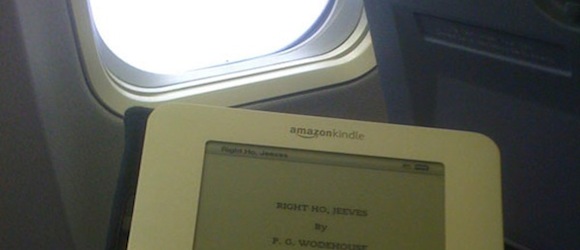Finally: The FAA Might Let Us Keep All Our Stuff Turned On During Flights
Cautiously Optimistic

I got my first eReader this summer, and it’s been a pretty positive experience overall. I’ve been catching up on a lot of classics, many of which are available free from things like Project Gutenberg, waxing nostalgic over digital copies of comics from the early 2000s. Maybe the most shocking thing about it to me is discovering how incredibly easy it is to check out ebooks from the library completely free of charge. But there is definitely one way in which it was inferior to a regular book.
I had to turn it off while my plane was taking off and landing. However, the humble eReader might fully surpass that limitation in less than a year, pending a newly announced consideration by the Federal Aviation Administration.
The FAA announced today that it will be taking comments and eventually forming a committee to investigate overturning or changing its stance on PEDs (that’s Personal Electronic Devices to you plebs) and how they can be used mid-flight.
Once all the comments have been collected, the FAA intends to establish an Aviation Rulemaking Committee (ARC) to review the comments and provide recommendations that might permit the more widespread use of PEDs during flight while maintaining the highest levels of safety for the passengers and aircraft.
The ban on PEDs has never been the most popular one, nor one grounded in much hard scientific evidence. As IGN points out:
The decades-old federal regulation, which requires passengers to keep all personal electronics turned off when their aircraft is below 10,000 feet, has been questioned by everyone from Alec Baldwin to the New York Times.
The fact is that when a flight attendant declares that your iPhone “interferes with our navigational equipment,” it’s almost always a lie. Cell phones can’t touch the radio frequencies reserved for aviation, and all but the most rickety old regional jets have shielded instruments to prevent interference.
The FAA admits that electronic devices have changed over time, each separate device now offering a whole host of possible and unique combinations of signal sending, as has their use. The basic black and white Kindle, for example, uses no power and therefore does not emit any kind of electronic signal or radiation, except for the brief moment when the user turns a page. Aircraft technology has changed as well, and that alone, they imply, would be a reason to revisit the rules. Part of the announcement, however, is concerned with less easily quantifiable effects of allowing electronic devices to remain on at all times, like passengers not paying attention to early-flight security briefings, bothering neighbors by talking on their cellphones mid-flight, or being encumbered with a large device like a laptop in case of an emergency during takeoff or landing.
Have a tip we should know? tips@themarysue.com